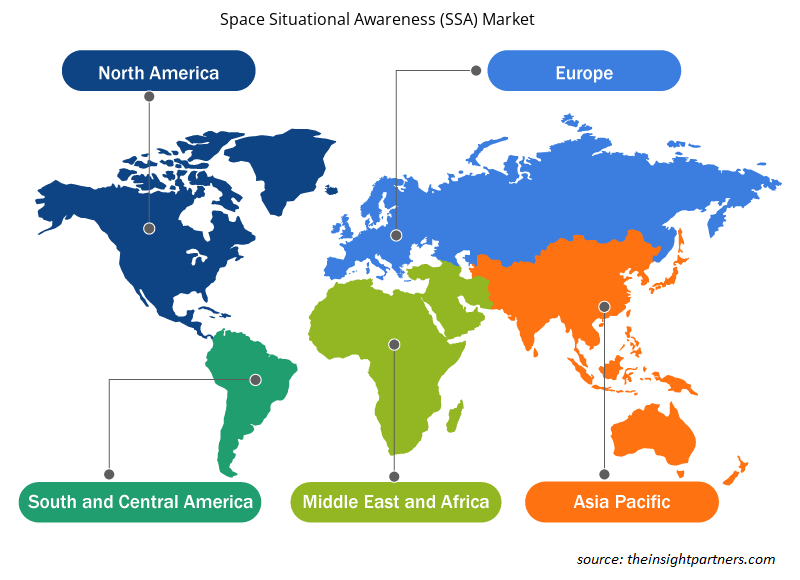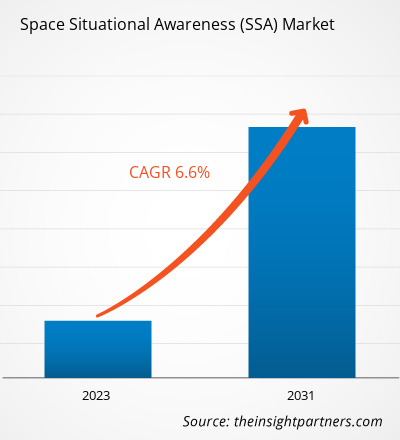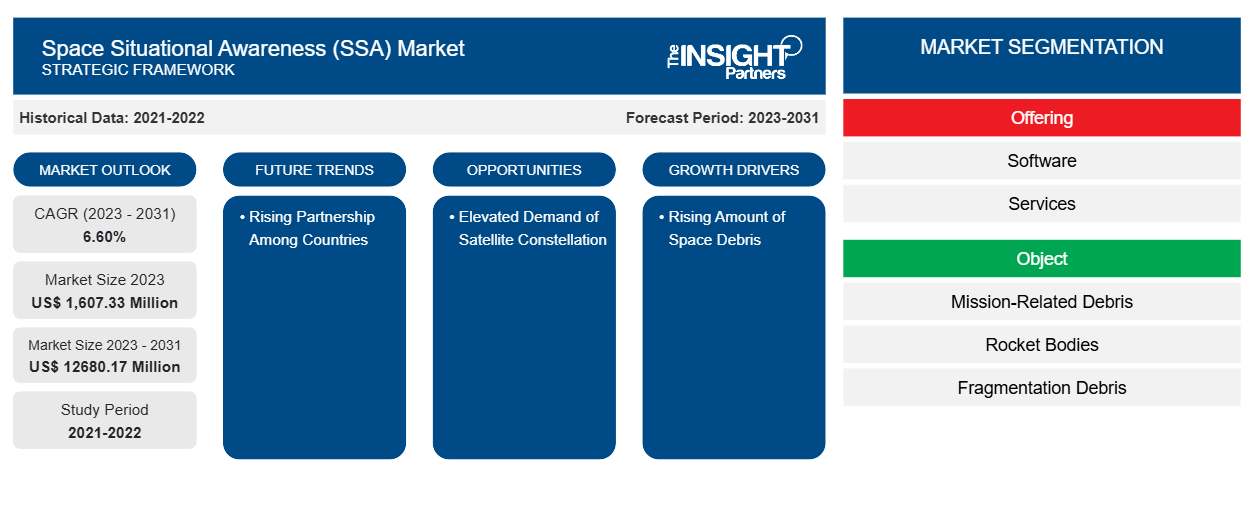Der Markt für Weltraumlagebewusstsein (SSA) soll von 1.607,33 Millionen US-Dollar im Jahr 2023 auf 12.680,17 Millionen US-Dollar im Jahr 2031 anwachsen. Der Markt soll bis 2031 mit einer durchschnittlichen jährlichen Wachstumsrate von 6,60 % wachsen. Das Wachstum des Marktes für Weltraumlagebewusstsein wird von Ländern mit bedeutenden Weltraumforschungsorganisationen, steigenden Investitionen in die Weltraumforschung und neuen Arten von Weltraumoperationen vorangetrieben, die neue Bedrohungen für die Aufrechterhaltung präziser Informationen über die Umlaufbahnen von Weltraumobjekten mit sich bringen. Die USA, Russland, China, Großbritannien, Japan und Frankreich sind einige der großen Länder, die die meisten Satelliten im Weltraum betreiben.
Marktanalyse für Weltraumsituationsbewusstsein (SSA)
Eine Reihe von Objekten wie Sonden, Satelliten, bemannte Raumfahrzeuge, Lander und Flugelemente von Raumstationen werden für interplanetare Erkundungsmissionen in die Erdumlaufbahn und darüber hinaus gebracht, um ein besseres Verständnis des Kosmos zu erlangen. Laut dem Büro der Vereinten Nationen für Weltraumfragen (UNOOSA) wurden im Jahr 2022 2.163 Objekte in den Weltraum gebracht, während in den Jahren 2021 und 2020 insgesamt 1.810 bzw. 1.274 Objekte gestartet wurden. Auch die Zahl der Weltraumraketenstarts, vor allem zur Stationierung von Satelliten im Weltraum, steigt rasant an. Im Jahr 2021 gab es 136 erfolgreiche Raketenstarts, während die Zahl im Jahr 2022 auf 180 stieg. Im ersten Halbjahr 2022 starteten US-amerikanische Unternehmen 37 Raketen, davon 27 von SpaceX, 4 von RocketLab, 3 von United Launch Alliance und 1 von Astra, Northrop Grumman und Virgin Orbit. China, Russland und Indien starteten im ersten Halbjahr 2022 21, 9 bzw. 2 Raketen. Von den 21 Raketenstarts Chinas brachte die Rakete Kuaizhou 1A einen kleinen Forschungssatelliten namens Tianxing 1 in eine niedrige polare Umlaufbahn weniger als 290 km über der Erde. Im Januar 2023 startete China erneut 14 Satelliten auf einer Trägerrakete vom Typ Langer Marsch-2D vom Satellitenstartzentrum Taiyuan in der nordchinesischen Provinz Shanxi. Zu den 14 Satelliten gehörten Qilu-2 und Qilu-3, Luojia-3 01 und Jilin-1 Gaofen 03D34. Im Februar 2023 gab die indische Weltraumforschungsorganisation (ISRO) den erfolgreichen Einsatz von drei Satelliten in ihren vorgesehenen Umlaufbahnen mit dem Fahrzeug SSLV-D2 bekannt.
Marktübersicht zur Weltraumsituationserkennung (SSA)
Die Weltraumlageerkennung (Space Situational Awareness, SSA) ist ein wichtiger Bestandteil der Weltraumlageerkennung (Space Domain Awareness, SDA), die Entscheidungsträgern hilft, aktuelle und vorhergesagte Betriebsumgebungen zu verstehen. Die SSA verfolgt und identifiziert Objekte, die dabei helfen, ihre Umlaufbahnen zu bestimmen, ihre funktionale Umgebung zu verstehen und zukünftige Positionen und Herausforderungen für ihren Betrieb vorherzusagen. Außerdem hilft die SSA dabei, Trümmer von Meteoritenstürmen, Fragmentierungsereignissen oder anderen potenziellen Naturereignissen abzuschätzen, die Weltraumoperationen beeinträchtigen könnten. Die SSA ist eine Grundlage für alle Aktivitäten im Bereich Weltraumverkehrsmanagement (Space Traffic Management, STM) und Weltraumsicherheit. Daher treiben all diese Vorteile der SSA ihre Verbreitung voran.
Passen Sie diesen Bericht Ihren Anforderungen an
Sie erhalten kostenlos individuelle Anpassungen an jedem Bericht, einschließlich Teilen dieses Berichts oder einer Analyse auf Länderebene, eines Excel-Datenpakets sowie tolle Angebote und Rabatte für Start-ups und Universitäten.
-
Holen Sie sich die wichtigsten Markttrends aus diesem Bericht.Dieses KOSTENLOSE Beispiel umfasst eine Datenanalyse von Markttrends bis hin zu Schätzungen und Prognosen.
Markttreiber und Chancen für Space Situational Awareness (SSA)
Steigende Menge an Weltraummüll
Im Jahr 2021 meldete Space Track vier Zerfallsereignisse im Orbit, bei denen 150 Fragmente erzeugt wurden, und zwei Kollisionsereignisse, bei denen 942 Objekte erzeugt wurden, darunter auch das Objekt aus dem russischen ASAT-Test. Diese umlaufenden Weltraumtrümmer bedrohen etwa 3.000 funktionierende Satelliten, die sich derzeit im Orbit befinden und für moderne kritische Kommunikation und andere Zwecke verwendet werden. Jeder Schaden, auch der kleinste, an solchen Weltraumgütern kann kaskadierende Auswirkungen auf viele lebenswichtige Systeme haben, darunter Kommunikation , Transport, Zeitplanung und kritische verteidigungsbezogene Aspekte. Viele hochmoderne Verteidigungstechnologien wie Lenkflugkörper, Drohnen, nachrichtendienstliche Datensammlungen, verschlüsselte Kommunikation und Navigation wären mit nicht mehr funktionierenden Satellitensystemen eingeschränkt oder könnten funktionsunfähig werden. Daher ist es von entscheidender Bedeutung, den vergleichenden Ansatz aller Weltraumobjekte zu analysieren, um Kollisionsgefahren frühzeitig zu erkennen. SSA befasst sich mit der gründlichen Kenntnis der Weltraumumgebung, der Bewertung jeglicher Bedrohungen für Weltraumaktivitäten und der Umsetzung notwendiger Minderungsmaßnahmen zum Schutz funktionsfähiger Weltraumgüter. Es spielt daher eine entscheidende Rolle bei der Gewährleistung sicherer und nachhaltiger Weltraumaktivitäten, die nationalen und internationalen Richtlinien, Standards und anderen Normen entsprechen. Aufgrund der kritischen Funktionalität von SSA und der zunehmenden Bedeutung von Satelliten wirkt sich die zunehmende Menge an Weltraummüll positiv auf den Markt für Weltraumlagebewusstsein aus.
Wachsende Partnerschaft zwischen Ländern
Weltraumressourcen gewinnen für mehrere Länder an Bedeutung, vor allem im Hinblick auf die nationale Sicherheit. Das wachsende Interesse an der Bereitstellung von Weltraumressourcen und der Gewährleistung ihrer langen Funktionsdauer führt zu mehreren Partnerschaften zwischen Ländern. Solche Partnerschaften decken mehrere Aspekte weltraumbezogener gemeinsamer Missionen und des Informationsaustauschs ab, was wiederum vielversprechende Wachstumschancen für den Markt für Weltraumlageerfassung bieten dürfte. Im April 2022 unterzeichneten Indien und die USA eine neue SSA-Vereinbarung. Die Partnerschaft soll neue Verteidigungsaustausche im Weltraum zwischen dem US Space Command und der indischen Verteidigungs- und Weltraumagentur in Gang setzen. Im Dezember 2021 unterzeichneten Australien und Südkorea eine Absichtserklärung (MoU), um bei der Weltraumerkundung, Startdiensten und Satellitennavigation zusammenzuarbeiten und ihre jeweiligen Kapazitäten in den Bereichen SSA, Erdbeobachtung, Weltraumverkehr und Trümmermanagement zu verbessern. Im November 2021 führten Japan und Indien einen virtuellen Weltraumdialog, um Informationen über die Weltraumpolitik beider Länder auszutauschen und über Weltraumsicherheit, die bilaterale Zusammenarbeit zwischen der Japan Aerospace Exploration Agency (JAXA) und der ISRO, ihre Weltraumindustrien, weltraumbezogene Regeln und Normen, globale Navigationssatellitensysteme, SSA und andere Bereiche von gemeinsamem Interesse zu diskutieren. Im März 2019 unterzeichneten die Regierungen Japans und der USA Abkommen zur Verknüpfung der SSA-Systeme der japanischen Selbstverteidigungsstreitkräfte (SDF) und des US-Militärs ab dem Geschäftsjahr 2023, um Echtzeitinformationen über Satelliten und Weltraummüll von Drittländern usw. auszutauschen. Solche Partnerschaften und Abkommen zwischen verschiedenen Ländern verdeutlichen die wachsende Bedeutung des Weltraums, der verfügbaren Weltraumressourcen und der SSA für die verschiedenen Regierungen, was in naher Zukunft reichlich Wachstumschancen für den Markt für Weltraumlagebewusstsein bieten dürfte.
Segmentierungsanalyse des Marktberichts zur Weltraumsituationserkennung (SSA)
Wichtige Segmente, die zur Ableitung der Marktanalyse für Weltraumsituationsbewusstsein (SSA) beigetragen haben, sind Angebot, Objekt, Endbenutzer und Umlaufbahnreichweite.
- Der Markt für Weltraumlageerkennung ist nach Angebot in Software und Service unterteilt. Das Servicesegment hatte im Jahr 2023 einen größeren Marktanteil.
- Der Markt für Weltraumlageerkennung ist nach Objekten in missionsbezogene Trümmer, Raketenkörper, Splittertrümmer, funktionsfähige Raumfahrzeuge und nicht funktionsfähige Raumfahrzeuge unterteilt. Das Segment Splittertrümmer hatte im Jahr 2023 einen größeren Marktanteil.
- Nach Endnutzern ist der Markt für Weltraumlagebewusstsein in kommerzielle und staatliche und militärische Anwendungen unterteilt. Das staatliche und militärische Segment hatte im Jahr 2023 einen größeren Marktanteil.
- Basierend auf der Umlaufbahn ist der Markt für Weltraumlageerkennung in den Weltraum und den erdnahen Bereich unterteilt. Das erdnahe Segment hatte im Jahr 2023 einen größeren Marktanteil.
Marktanteilsanalyse für Space Situational Awareness (SSA) nach geografischen Gesichtspunkten
Der globale Markt für Weltraumlagebewusstsein (Space Situational Awareness, SSA) ist grob in Nordamerika, Europa, Asien-Pazifik (APAC) und Rest der Welt (Rest der Welt) unterteilt. Die zunehmende Gefahr einer Kollision von Weltraummüll mit Weltraumressourcen ist zu einem ständigen Problem für die nachhaltige und sichere Nutzung des Weltraums geworden. Diese Bedrohungen schränken den ungehinderten Zugang zum Weltraum ein und zwingen die Weltraumbehörden, geeignete Maßnahmen zu ihrer Eindämmung zu ergreifen. Die Entwicklung von Programmen für Weltraumlagebewusstsein (Space Situational Awareness, SSA) in den USA hilft dabei, verschiedene Bedrohungen durch von Menschenhand geschaffene Objekte zu überwachen, darunter andere Satelliten, Raumschiffe, Antisatellitenwaffen und Weltraummüll. SSA dient in den USA auch der Verfolgung militärischer Ziele, darunter der Vorbereitung von Verteidigungs- und Angriffsoperationen.
Die US-Regierung stellt Kadetten und Lehrkräften der US Air Force Academy über das Center for Space Situational Awareness Research (CSSAR) ein Bildungs- und Forschungsprogramm zur Lageerkennung im Weltraum zur Verfügung, das erstklassige Kapazitäten und Einrichtungen nutzt. CSSAR hilft auch dabei, Informationen zu spektralen, nicht bildgebenden photometrischen und polarimetrischen Techniken bereitzustellen, die zur Charakterisierung und Identifizierung nicht aufgelöster Weltraumobjekte führen. Es hilft auch bei der Fusion unterschiedlicher Datenquellen, wodurch die Lageerkennung maximiert und die optischen Sensorfähigkeiten weiterentwickelt werden. CSSAR hat auch ein Netzwerk kleiner Aperturteleskope entwickelt, das dazu beitragen kann, eine globale Abdeckung des Weltraumkatalogs bereitzustellen und die Fähigkeit zu verbessern, Satelliten gleichzeitig von mehreren Teleskopstandorten aus für die Datenfusionsforschung zu beobachten.
Regionale Einblicke in den Markt für Weltraumsituationsbewusstsein (SSA)
Die regionalen Trends und Faktoren, die den Markt für Weltraumlagebewusstsein (SSA) während des Prognosezeitraums beeinflussen, wurden von den Analysten von Insight Partners ausführlich erläutert. In diesem Abschnitt werden auch die Marktsegmente und die Geografie für Weltraumlagebewusstsein (SSA) in Nordamerika, Europa, im asiatisch-pazifischen Raum, im Nahen Osten und Afrika sowie in Süd- und Mittelamerika erörtert.

- Holen Sie sich die regionalen Daten für den Markt für Weltraumsituationsbewusstsein (Space Situational Awareness, SSA)
Umfang des Marktberichts zur Weltraumsituationserkennung (SSA)
| Berichtsattribut | Details |
|---|---|
| Marktgröße im Jahr 2023 | 1.607,33 Millionen US-Dollar |
| Marktgröße bis 2031 | 12680,17 Millionen US-Dollar |
| Globale CAGR (2023 - 2031) | 6,60 % |
| Historische Daten | 2021-2022 |
| Prognosezeitraum | 2023–2031 |
| Abgedeckte Segmente |
Durch das Angebot
|
| Abgedeckte Regionen und Länder |
Nordamerika
|
| Marktführer und wichtige Unternehmensprofile |
|
Dichte der Marktteilnehmer im Bereich Space Situational Awareness (SSA): Die Auswirkungen auf die Geschäftsdynamik verstehen
Der Markt für Weltraumsituationsbewusstsein (Space Situational Awareness, SSA) wächst rasant. Dies wird durch die steigende Nachfrage der Endnutzer aufgrund von Faktoren wie sich entwickelnden Verbraucherpräferenzen, technologischen Fortschritten und einem größeren Bewusstsein für die Vorteile des Produkts vorangetrieben. Mit der steigenden Nachfrage erweitern Unternehmen ihr Angebot, entwickeln Innovationen, um die Bedürfnisse der Verbraucher zu erfüllen, und nutzen neue Trends, was das Marktwachstum weiter ankurbelt.
Die Marktteilnehmerdichte bezieht sich auf die Verteilung der Firmen oder Unternehmen, die in einem bestimmten Markt oder einer bestimmten Branche tätig sind. Sie gibt an, wie viele Wettbewerber (Marktteilnehmer) in einem bestimmten Marktraum im Verhältnis zu seiner Größe oder seinem gesamten Marktwert präsent sind.
Die wichtigsten Unternehmen auf dem Markt für Weltraumsituationsbewusstsein (Space Situational Awareness, SSA) sind:
- Analytische Grafiken, Inc.
- Exoanalytic Solutions, Inc
- Globvision Inc.
- GMV Innovating Solutions SL
- L3Harris Technologies, Inc.
- Kratos Defense und Sicherheitslösungen, Inc.
Haftungsausschluss : Die oben aufgeführten Unternehmen sind nicht in einer bestimmten Reihenfolge aufgeführt.

- Überblick über die wichtigsten Akteure auf dem Markt für Space Situational Awareness (SSA)
Marktnachrichten und aktuelle Entwicklungen zur Weltraumsituationserkennung (Space Situational Awareness, SSA)
Der Markt für Weltraumsituationsbewusstsein (SSA) wird durch die Erfassung qualitativer und quantitativer Daten nach Primär- und Sekundärforschung bewertet, die wichtige Unternehmensveröffentlichungen, Verbandsdaten und Datenbanken umfasst. Im Folgenden finden Sie eine Liste der Entwicklungen auf dem Markt für Innovationen, Geschäftserweiterungen und Strategien:
- Im April 2022 unterstützt Ansys (NASDAQ:ANSS) Government Initiatives (AGI) Northrop Grumman bei der Entwicklung, Erprobung und Bereitstellung einer Deep-Space Advanced Radar Capability (DARC) zur Unterstützung der Space Domain Awareness-Mission des Space Systems Command (SSC) der US Space Force (USSF). (Quelle: Ansys, Pressemitteilung)
- Im September 2022 rechnet ExoAnalytic Solutions mit der Rückkehr Amerikas zum Mond mit Artemis. Im Rahmen ihrer Unterstützung des Blue Horizons Fellowship-Programms der Air Force und ihrer Bemühungen zur cislunaren Verfolgung im Rahmen von Project Rocket demonstriert das Unternehmen die Anwendung seiner weltweit führenden Dienste zur Weltraumüberwachung beim Flugtest von Artemis I. (Quelle: ExoAnalytic Solutions, Pressemitteilung)
Marktbericht zur Weltraumsituationserkennung (Space Situational Awareness, SSA) – Abdeckung und Ergebnisse
Der Bericht „Marktgröße und Prognose für Space Situational Awareness (SSA) (2021–2031)“ bietet eine detaillierte Analyse des Marktes, die die folgenden Bereiche abdeckt:
- Marktgröße und Prognose zur Weltraumsituationserkennung (SSA) auf globaler, regionaler und Länderebene für alle abgedeckten wichtigen Marktsegmente.
- Marktdynamik wie Treiber, Beschränkungen und wichtige Chancen
- Markttrends zur Weltraumlageerfassung (SSA)
- Detaillierte PEST/Porters Five Forces- und SWOT-Analyse
- Marktanalyse zur Weltraumsituationserkennung (Space Situational Awareness, SSA), die wichtige Markttrends, globale und regionale Rahmenbedingungen, wichtige Akteure, Vorschriften und aktuelle Marktentwicklungen umfasst
- Marktlandschaft und Wettbewerbsanalyse zur Weltraumsituationserkennung (SSA), einschließlich Marktkonzentration, Heatmap-Analyse, prominenten Akteuren und aktuellen Entwicklungen.
- Detaillierte Firmenprofile
- Historische Analyse (2 Jahre), Basisjahr, Prognose (7 Jahre) mit CAGR
- PEST- und SWOT-Analyse
- Marktgröße Wert/Volumen – Global, Regional, Land
- Branchen- und Wettbewerbslandschaft
- Excel-Datensatz
Aktuelle Berichte
Erfahrungsberichte
Grund zum Kauf
- Fundierte Entscheidungsfindung
- Marktdynamik verstehen
- Wettbewerbsanalyse
- Kundeneinblicke
- Marktprognosen
- Risikominimierung
- Strategische Planung
- Investitionsbegründung
- Identifizierung neuer Märkte
- Verbesserung von Marketingstrategien
- Steigerung der Betriebseffizienz
- Anpassung an regulatorische Trends























 Kostenlose Probe anfordern für - Markt für Weltraumlagebewusstsein (SSA)
Kostenlose Probe anfordern für - Markt für Weltraumlagebewusstsein (SSA)